Chemical Composition, Microstructure, Tensile and Creep Behavior of Ti60 Alloy Fabricated via Electron Beam Directed Energy Deposition
Abstract
:1. Introduction
2. Materials and Methods
3. Results and Discussion
3.1. Chemical Compositions
3.2. Macro- and Microstructure Evolution
3.3. Mechanical Properties
3.3.1. Tensile Properties at Room Temperature and 600 °C
3.3.2. Tensile Creep Properties at 600 °C
4. Conclusions
- The selective evaporation of elements occurred during EB-DED. The average evaporation losses of Al and Sn were 10.28% and 5.01%, respectively. Compared with the wire feedstock, the H content of the as-built sample significantly decreased from 0.0044 to 0.0008% owing to the high-vacuum environment.
- The as-built macrostructure was characterized by coarse columnar grains. Within the prior-β grains, a lamellar α microstructure and elliptical (Ti, Zr)6Si3 silicides precipitated from the α/β interface. The long axis of the silicides had a length of 40~350 nm. The orientation relationship between the silicide and the α-Ti phase was determined as (0110)S2//(0112)α-Ti. After the post-deposition solution and aging treatment (STA), the α-laths coarsened from 1.19 μm to 2.05 μm. Compared with the as-built specimens, a larger amount of silicides precipitated at the α/β interface of the post-deposition STA specimens.
- The tensile strength of the as-built and post-deposition STA specimens was lower than that of their wrought counterparts (both lamellar and bimodal microstructures). This is attributed to the larger prior-β grain size and the evaporation loss of elements in the former. Compared to the as-built specimens, the post-deposition STA specimens exhibited inferior strength but superior ductility. The horizontal specimens exhibited slightly higher strength but lower ductility than the vertical specimens at both temperatures (room temperature and 600 °C).
- The tensile creep strain of the EB-DED Ti60 alloy measured at 600 °C and 150 MPa for 100 h under as-built and post-deposition STA conditions was less than 0.15%, which meets the standard requirements of the wrought counterpart (≤0.2%). The lower Si content in the α matrix and the coarser lamellar α phase in the post-deposition STA specimen explain its inferior creep resistance compared to the as-built specimen. The creep resistance of the EB-DED Ti60 alloy was superior to that of its wrought bimodal counterpart, whereas it was inferior to that of the wrought lamellar specimen.
- After the creep test, the ordered α2 (Ti3Al) phases precipitated from the lamellar α matrix, with a high density of dislocations pinned at the α/β interfaces and silicide precipitates.
Author Contributions
Funding
Institutional Review Board Statement
Informed Consent Statement
Data Availability Statement
Acknowledgments
Conflicts of Interest
References
- Peters, M.; Hemptenmacher, J.; Kumpfert, J.; Leyens, C. Structure and properties of titanium and titanium alloys. Titan. Titan. Alloy 2003, 1–36. [Google Scholar] [CrossRef]
- Mishra, H.; Ghosal, P.; Nandy, T.K.; Sagar, P.K. Influence of Fe and Ni on creep of near alpha-Ti Alloy IM1834. Mater. Sci. Eng. A 2005, 399, 222–231. [Google Scholar] [CrossRef]
- Chandravanshi, V.K.; Sarkar, R.; Kamat, S.V.; Nandy, T.K. Effect of boron on microstructure and mechanical properties of thermomechanically processed near alpha titanium alloy Ti-1100. J. Alloy Compd. 2011, 509, 5506–5514. [Google Scholar] [CrossRef]
- Tetyukhin, V.; Levin, I.; Ilyenko, V. Heat resistant titanium alloys with enhanced, heat resistant, thermal stability. Titan. Sci. Technol. 1966, 3, 2403–2404. [Google Scholar]
- Sun, F.; Li, J.S.; Kou, H.C.; Tang, B.; Chen, Y.; Chang, H.; Cai, J.M. Beta phase transformation kinetics in Ti60 alloy during continuous cooling. J. Alloy Compd. 2013, 576, 108–113. [Google Scholar] [CrossRef]
- Deng, M.; Sui, S.; Yao, B.; Ma, L.; Lin, X.; Chen, J. Microstructure and room-temperature tensile property of Ti-5.7Al-4.0Sn-3.5Zr-0.4Mo-0.4Si-0.4Nb-1.0Ta-0.05C with near equiaxed β grain fabricated by laser directed energy deposition technique. J. Mater. Sci. Technol. 2022, 101, 308–320. [Google Scholar] [CrossRef]
- Li, N.; Huang, S.; Zhang, G.; Qin, R.; Liu, W.; Xiong, H.; Shi, G.; Blackburn, J. Progress in additive manufacturing on new materials: A review. J. Mater. Sci. Technol. 2019, 35, 242–269. [Google Scholar] [CrossRef]
- Oliveira, J.P.; Santos, T.G.; Miranda, R.M. Revisiting fundamental welding concepts to improve additive manufacturing: From theory to practice. Prog. Mater. Sci. 2020, 107, 100590. [Google Scholar] [CrossRef]
- Kok, Y.; Tan, X.P.; Wang, P.; Nai, M.L.S.; Loh, N.H.; Liu, E.; Tor, S.B. Anisotropy and heterogeneity of microstructure and mechanical properties in metal additive manufacturing: A critical review. Mater. Des. 2018, 139, 565–586. [Google Scholar] [CrossRef]
- Shah, Z.; Vrinceanu, N.; Rooman, M.; Deebani, W.; Shutaywi, M. Mathematical modelling of Ree-Eyring nanofluid using Koo-Kleinstreuer and Cattaneo-Christov models on chemically reactive AA7072-AA7075 alloys over a magnetic dipole stretching surface. Coatings 2022, 12, 391. [Google Scholar] [CrossRef]
- Cook, P.S.; Murphy, A.B. Simulation of melt pool behaviour during additive manufacturing: Underlying physics and progress. Addit. Manuf. 2020, 31, 100909. [Google Scholar] [CrossRef]
- Zhang, J.; Li, X.; Xu, D.; Yang, R. Recent progress in the simulation of microstructure evolution in titanium alloys. Prog. Nat. Sci. Mater. Int. 2019, 29, 295–304. [Google Scholar] [CrossRef]
- DebRoy, T.; Wei, H.L.; Zuback, J.S.; Mukherjee, T.; Elmer, J.W.; Milewski, J.O.; Beese, A.M.; Wilson-Heid, A.; De, A.; Zhang, W. Additive manufacturing of metallic components—Process, structure and properties. Prog. Mater. Sci. 2018, 92, 112–224. [Google Scholar] [CrossRef]
- Chen, J.; Zhang, R.; Zhang, Q.; Yang, J.Q.; Huang, W.D. Relationship among microstructure, defects and performance of Ti60 titanium alloy fabricated by laser solid forming. Rare Met. Mater. Eng. 2014, 43, 548–552. [Google Scholar] [CrossRef]
- Zhang, A.; Liu, D.; Wu, X.H.; Wang, H.M. Effect of heat treatment on microstructure and mechanical properties of laser deposited Ti60A alloy. J. Alloy Compd. 2014, 585, 220–228. [Google Scholar] [CrossRef]
- Ding, D.H.; Pan, Z.X.; Cuiuri, D.; Li, H.J. Wire-feed additive manufacturing of metal components: Technologies, developments and future interests. Int. J. Adv. Manuf. Technol. 2015, 81, 465–481. [Google Scholar] [CrossRef]
- Butler, T.M.; Brice, C.A.; Tayon, W.A.; Semiatin, S.L.; Pilchak, A.L. Evolution of texture from a single crystal Ti-6Al-4V substrate during electron beam directed energy deposition. Metall. Mater. Trans. A 2017, 48A, 4441–4446. [Google Scholar] [CrossRef]
- Osipovich, K.; Vorontsov, A.; Chumaevskii, A.; Moskvichev, E.; Zakharevich, I.; Dobrovolsky, A.; Sudarikov, A.; Zykova, A.; Rubtsov, V.; Kolubaev, E. Features of microstructure and texture formation of large-sized blocks of C11000 copper produced by electron beam wire-feed additive technology. Materials 2022, 15, 814. [Google Scholar] [CrossRef] [PubMed]
- Eshawish, N.; Malinov, S.; Sha, W.; Walls, P. Microstructure and mechanical properties of Ti-6Al-4V manufactured by selective laser melting after stress relieving, hot isostatic pressing treatment, and post-heat treatment. J. Mater. Eng. Perform. 2021, 30, 5290–5296. [Google Scholar] [CrossRef]
- Carrozza, A.; Aversa, A.; Fino, P.; Lombardi, M. A Study on the microstructure and mechanical properties of the Ti-6Al-2Sn-4Zr-6Mo alloy produced via laser powder bed fusion. J. Alloy Compd. 2021, 870, 159329. [Google Scholar] [CrossRef]
- Hasib, M.T.; Liu, Q.; Ostergaard, H.E.; Li, X.P.; Kruzic, J.J. Fracture toughness anisotropy of commercially pure titanium produced by laser powder bed fusion additive manufacturing. Int. J. Fract. 2022; in press. [Google Scholar] [CrossRef]
- Sandell, V.; Hansson, T.; Roychowdhury, S.; Månsson, T.; Delin, M.; Åkerfeldt, P.; Antti, M.-L. Defects in electron beam melted Ti-6Al-4V: Fatigue life prediction using experimental data and extreme value statistics. Materials 2021, 14, 640. [Google Scholar] [CrossRef] [PubMed]
- Pessard, E.; Lavialle, M.; Laheurte, P.; Didier, P.; Brochu, M. High-cycle fatigue behavior of a laser powder bed fusion additive manufactured Ti-6Al-4V titanium: Effect of pores and tested volume size. Int. J. Fatigue 2021, 149, 106206. [Google Scholar] [CrossRef]
- Kim, Y.K.; Park, S.H.; Yu, J.H.; AlMangour, B.; Lee, K.A. Improvement in the high-temperature creep properties via heat treatment of Ti-6Al-4V alloy manufactured by selective laser melting. Mater. Sci. Eng. A 2018, 715, 33–40. [Google Scholar] [CrossRef]
- Viespoli, L.M.; Bressan, S.; Itoh, T.; Hiyoshi, N.; Prashanth, K.G.; Berto, F. Creep and high temperature fatigue performance of as build selective laser melted Ti-based 6Al-4V titanium alloy. Eng. Fail. Anal. 2020, 111, 104477. [Google Scholar] [CrossRef]
- Spigarelli, S.; Paoletti, C.; Cabibbo, M.; Cerri, E.; Santecchia, E. On the creep performance of the Ti-6Al-4V alloy processed by additive manufacturing. Addit. Manuf. 2022, 49, 102520. [Google Scholar] [CrossRef]
- Omprakash, C.M.; Satyanarayana, D.V.; Kumar, V. Effect of primary alpha content on creep and creep crack growth behaviour of near alpha-Ti alloy. Mater. Sci. Technol. 2011, 27, 1427–1432. [Google Scholar] [CrossRef]
- Zhang, G.D.; Li, N.; Gao, J.S.; Xiong, H.P.; Yu, H.; Yuan, H. Wire-fed electron beam directed energy deposition of Ti-6Al-2Zr-1Mo-1V alloy and the effect of annealing on the microstructure, texture, and anisotropy of tensile properties. Addit. Manuf. 2022, 49, 102511. [Google Scholar] [CrossRef]
- Sun, F.; Li, J.; Kou, H.; Tang, B.; Cai, J. Nano-precipitation and tensile properties of Ti60 alloy after exposure at 550 °C and 650 °C. Mater. Sci. Eng. A 2015, 626, 247–253. [Google Scholar] [CrossRef]
- Juechter, V.; Scharowsky, T.; Singer, R.F.; Körner, C. Processing window and evaporation phenomena for Ti-6Al-4V produced by selective electron beam melting. Acta Mater. 2014, 76, 252–258. [Google Scholar] [CrossRef] [Green Version]
- Weglowski, M.S.; Blacha, S.; Phillips, A. Electron beam welding-techniques and trends-review. Vacuum 2016, 130, 72–92. [Google Scholar] [CrossRef]
- Truong, V.D.; Hyun, Y.T.; Won, J.W.; Lee, W.; Yoon, J. Numerical simulation of the effects of scanning strategies on the aluminum evaporation of titanium alloy in the electron beam cold hearth melting process. Materials 2022, 15, 820. [Google Scholar] [CrossRef] [PubMed]
- Xu, J.Q.; Zhou, Q.; Kong, J.; Peng, Y.; Guo, S.; Zhu, J.; Fan, J.K. Solidification behavior and microstructure of Ti-(37-52) at% Al alloys synthesized in situ via dual-wire electron beam freeform fabrication. Addit. Manuf. 2021, 46, 102113. [Google Scholar] [CrossRef]
- Tang, H.P.; Yang, G.Y.; Jia, W.P.; He, W.W.; Lu, S.L.; Qian, M. Additive manufacturing of a high niobium-containing titanium aluminide alloy by selective electron beam melting. Mater. Sci. Eng. A 2015, 636, 103–107. [Google Scholar] [CrossRef]
- Wang, D.W.; Liu, Z.G.; Liu, W.R. Experimental measurement of vacuum evaporation of aluminum in Ti-Al, V-Al, Ti6Al4V alloys by electron beam. Metals 2021, 11, 1688. [Google Scholar] [CrossRef]
- Pixner, F.; Warchomicka, F.; Peter, P.; Steuwer, A.; Colliander, M.H.; Pederson, R.; Enzinger, N. Wire-based additive manufacturing of Ti-6Al-4V using electron beam technique. Materials 2020, 13, 3310. [Google Scholar] [CrossRef]
- Xu, J.Q.; Zhu, J.; Fan, J.K.; Zhou, Q.; Peng, Y.; Guo, S. Microstructure and mechanical properties of Ti-6Al-4V alloy fabricated using electron beam freeform fabrication. Vacuum 2019, 167, 364–373. [Google Scholar] [CrossRef]
- Klassen, A.; Forster, V.E.; Juechter, V.; Körner, C. Numerical simulation of multi-component evaporation during selective electron beam melting of TiAl. J. Mater. Process. Technol. 2017, 247, 280–288. [Google Scholar] [CrossRef]
- Kubaschewski, O.; Alcock, C.B. Metallurgical Thermochemistry; Pergamon Press: Oxford, UK, 1979; Volume I, ISBN 0080208975. [Google Scholar]
- Li, J.; Zhou, X.; Brochu, M.; Provatas, N.; Zhao, Y.F. Solidification microstructure simulation of Ti-6Al-4V in metal additive manufacturing: A review. Addit. Manuf. 2020, 31, 100989. [Google Scholar] [CrossRef]
- Zhang, G.D.; Xiong, H.P.; Yu, H.; Qin, R.Y.; Liu, W.; Yuan, H. Microstructure evolution and mechanical properties of wire-feed electron beam additive manufactured Ti-5Al-2Sn-2Zr-4Mo-4Cr alloy with different subtransus heat treatments. Mater. Des. 2020, 195, 109063. [Google Scholar] [CrossRef]
- Jia, W.J.; Zeng, W.D.; Yu, H.Q. Effect of aging on the tensile properties and microstructures of a near-alpha titanium alloy. Mater. Des. 2014, 58, 108–115. [Google Scholar] [CrossRef]
- Madsen, A.; Andrieu, E.; Ghonem, H. Microstructural changes during aging of a near-α titanium alloy. Mater. Sci. Eng. A 1993, 171, 191–197. [Google Scholar] [CrossRef]
- Jia, W.J.; Zeng, W.D.; Liu, J.R.; Zhou, Y.G.; Wang, Q.J. Influence of thermal exposure on the tensile properties and microstructures of Ti60 titanium alloy. Mater. Sci. Eng. A 2011, 530, 511–518. [Google Scholar] [CrossRef]
- Zhang, A.; Liu, D.; Wang, H.M. Effect of thermal exposure on microstructure and tensile properties of laser deposited Ti60a alloy. Mater. Sci. Eng. A 2013, 562, 61–68. [Google Scholar] [CrossRef]
- Wang, T.B.; Li, B.L.; Wang, Z.Q.; Nie, Z.R. A microstructure with improved thermal stability and creep resistance in a novel near-alpha titanium alloy. Mater. Sci. Eng. A 2018, 731, 12–20. [Google Scholar] [CrossRef]
- Tabie, V.M.; Li, C.; Wang, S.F.; Li, J.W.; Xu, X.J. Mechanical properties of near alpha titanium alloys for high-temperature applications-a review. Aircr. Eng. Aerosp. Technol. 2020, 92, 521–540. [Google Scholar] [CrossRef]
- De Formanoir, C.; Michotte, S.; Rigo, O.; Germain, L.; Godet, S. Electron beam melted Ti-6Al-4V: Microstructure, texture and mechanical behavior of the as-built and heat-treated material. Mater. Sci. Eng. A 2016, 652, 105–119. [Google Scholar] [CrossRef]
- Barba, D.; Alabort, C.; Tang, Y.T.; Viscasillas, M.J.; Reed, R.C.; Alabort, E. On the size and orientation effect in additive manufactured Ti-6Al-4V. Mater. Des. 2020, 186, 108235. [Google Scholar] [CrossRef]
- Zhu, Y.Y.; Tian, X.J.; Li, J.; Wang, H.M. The Anisotropy of laser melting deposition additive manufacturing Ti-6.5Al-3.5Mo-1.5Zr-0.3Si titanium alloy. Mater. Des. 2015, 67, 538–542. [Google Scholar] [CrossRef]
- Davis, A.E.; Honnige, J.R.; Martina, F.; Prangnell, P.B. Quantification of strain fields and grain refinement in Ti-6Al-4V inter-pass rolled wire-arc am by EBSD misorientation analysis. Mater. Charact. 2020, 170, 110673. [Google Scholar] [CrossRef]
- Carroll, B.E.; Palmer, T.A.; Beese, A.M. Anisotropic tensile behavior of Ti-6Al-4V components fabricated with directed energy deposition additive manufacturing. ACTA Mater. 2015, 87, 309–320. [Google Scholar] [CrossRef]
- Es-Souni, M. Creep behaviour and creep microstructures of a high-temperature titanium alloy Ti–5.8Al–4.0Sn–3.5Zr–0.7Nb–0.35Si–0.06C (Timetal 834): Part I. primary and steady-state creep. Mater. Charact. 2001, 46, 365–379. [Google Scholar] [CrossRef]
- Chandravanshi, V.; Sarkar, R.; Kamat, S.V.; Nandy, T.K. Effects of thermomechanical processing and heat treatment on the tensile and creep properties of boron-modified near alpha titanium alloy Ti-1100. Metall. Mater. Trans. A 2013, 44, 201–211. [Google Scholar] [CrossRef]
- Rafi, H.K.; Karthik, N.V.; Gong, H.; Starr, T.L.; Stucker, B.E. Microstructures and mechanical properties of Ti6Al4V parts fabricated by selective laser melting and electron beam melting. J. Mater. Eng. Perform. 2013, 22, 3872–3883. [Google Scholar] [CrossRef]
- Nie, X.; Liu, H.Q.; Zhou, X.Z.; Yi, D.Q.; Huang, B.Y.; Hu, Z.; Xu, Y.F.; Yang, Q.; Wang, D.C.; Gao, Q. Creep of Ti-5Al-5Mo-5V-1Fe-1Cr alloy with equiaxed and lamellar microstructures. Mater. Sci. Eng. A 2016, 651, 37–44. [Google Scholar] [CrossRef]
- Sahoo, R.; Jha, B.B.; Sahoo, T.K. Effect of microstructure on the creep properties of Ti-6Al-4V alloys: An analysis. Trans. India Inst. Met. 2018, 71, 1573–1582. [Google Scholar] [CrossRef]
- Barboza, M.J.R.; Perez, E.A.C.; Medeiros, M.M.; Reis, D.A.P.; Nono, M.C.A.; Neto, F.P.; Silva, C.R.M. Creep behavior of Ti-6Al-4V and a comparison with titanium matrix composites. Mater. Sci. Eng. A 2006, 428, 319–326. [Google Scholar] [CrossRef]
- Balasundar, I.; Raghu, T.; Kashyap, B.P. Correlation between microstructural features and creep strain in a near-α titanium alloy processed in the α + β regime. Mater. Sci. Eng. A 2014, 609, 241–249. [Google Scholar] [CrossRef]
- Singh, A.K.; Roy, T.; Ramachandra, C. Microstructural stability on aging of an α + β titanium alloy: Ti-6Al-1.6Zr-3.3Mo-0.30Si. Metall. Mater. Trans. A 1996, 27, 1167–1173. [Google Scholar] [CrossRef]
- Gu, Y.; Zeng, F.H.; Qi, Y.L.; Xia, C.Q.; Xiong, X. Tensile creep behavior of heat-treated TC11 titanium alloy at 450–550 degree C. Mater. Sci. Eng. A 2013, 575, 74–85. [Google Scholar] [CrossRef]
- Singh, A.K.; Ramachandra, C. Characterization of silicides in high-temperature titanium alloys. J. Mater. Sci. 1997, 32, 229–234. [Google Scholar] [CrossRef]
- Dao, V.H.; Yu, J.M.; Yoon, K.B. Anisotropic creep behavior of stainless steel produced by selective laser melting. Mater. Sci. Eng. A 2020, 796, 140040. [Google Scholar] [CrossRef]
- Kuo, Y.L.; Horikawa, S.; Kakehi, K. Effects of build direction and heat treatment on creep properties of Ni-base superalloy built up by additive manufacturing. Scr. Mater. 2017, 129, 74–78. [Google Scholar] [CrossRef]
- Li, J.; Wang, L.; Qin, J.; Chen, Y.; Lu, W.; Zhang, D. The effect of heat treatment on thermal stability of Ti matrix composite. J. Alloy Compd. 2011, 509, 52–56. [Google Scholar] [CrossRef]

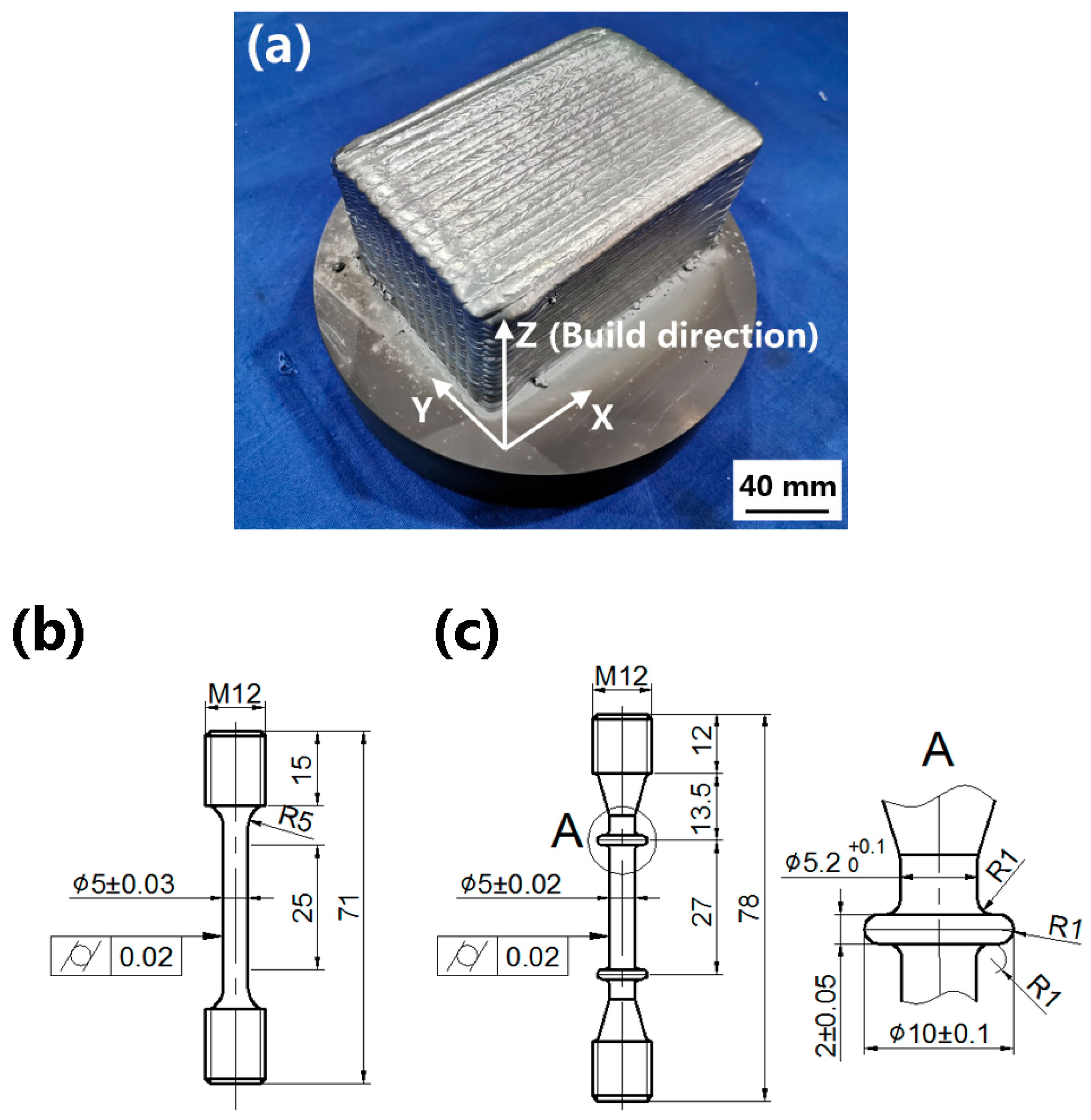
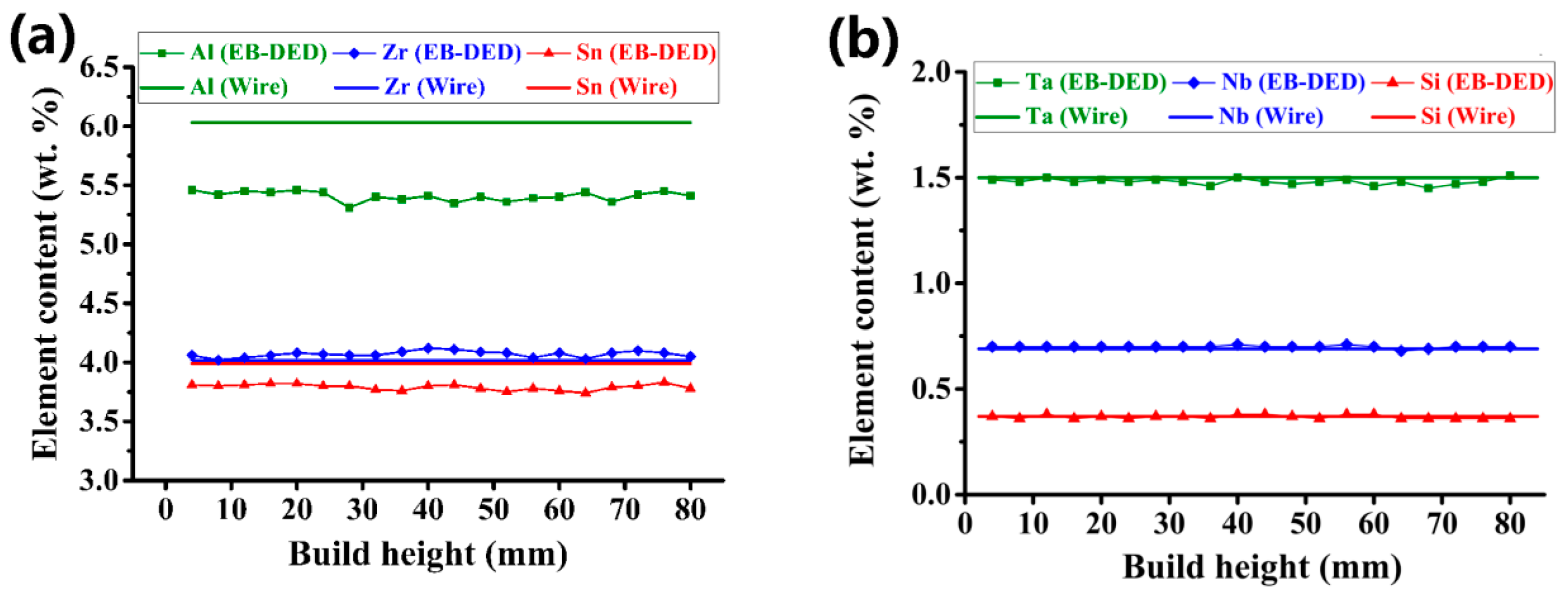
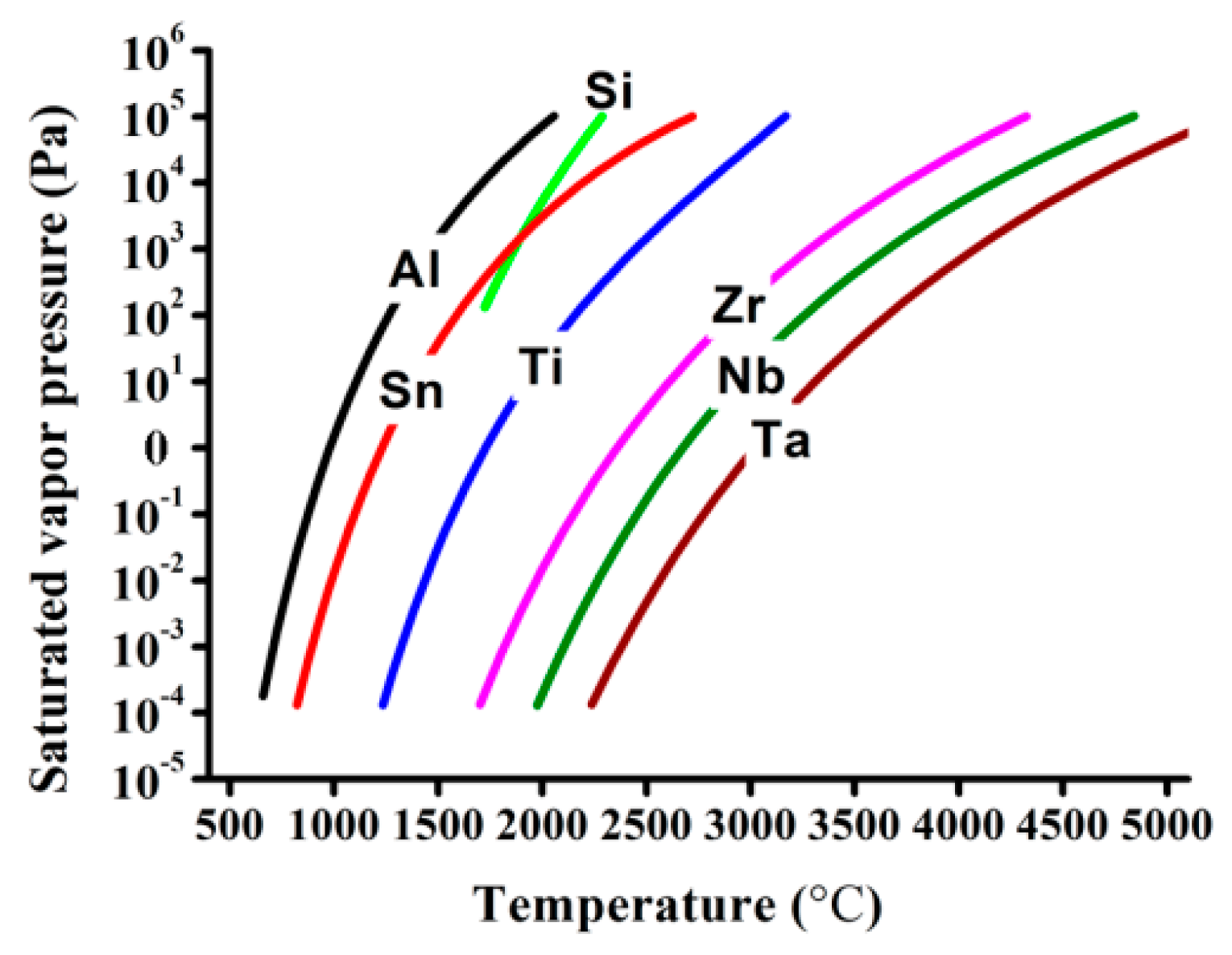
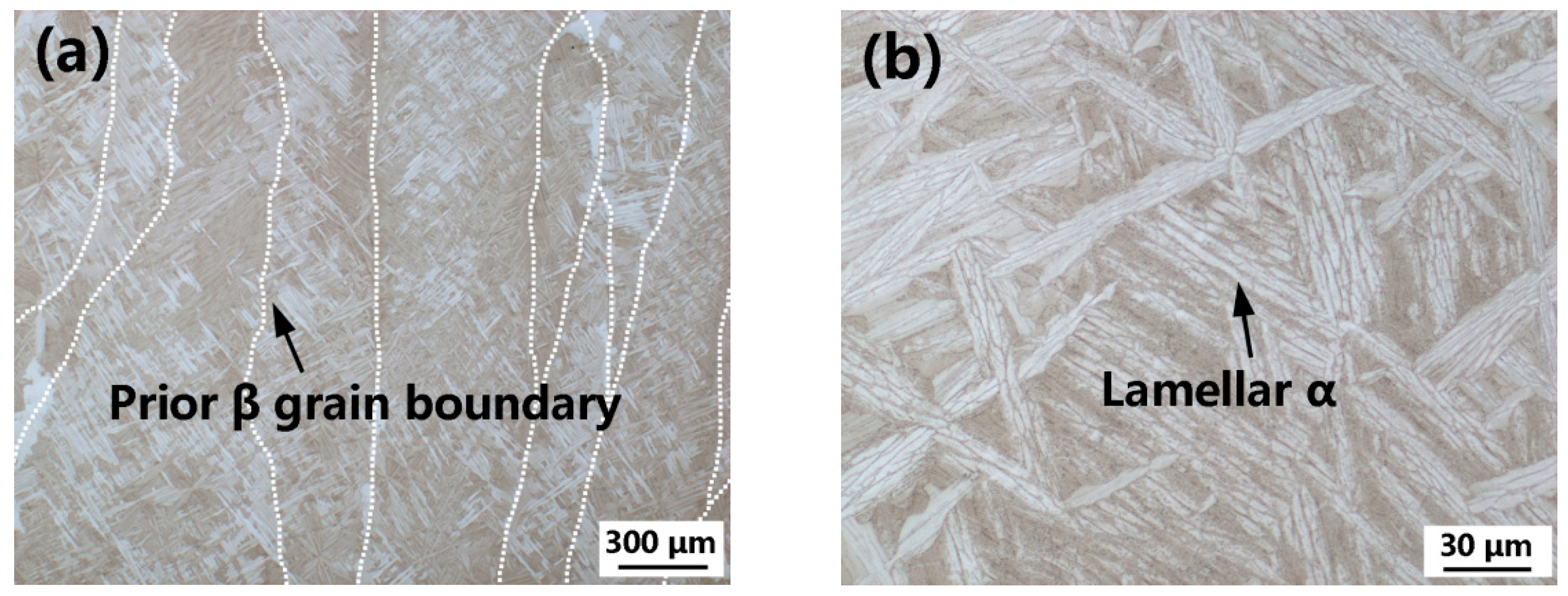
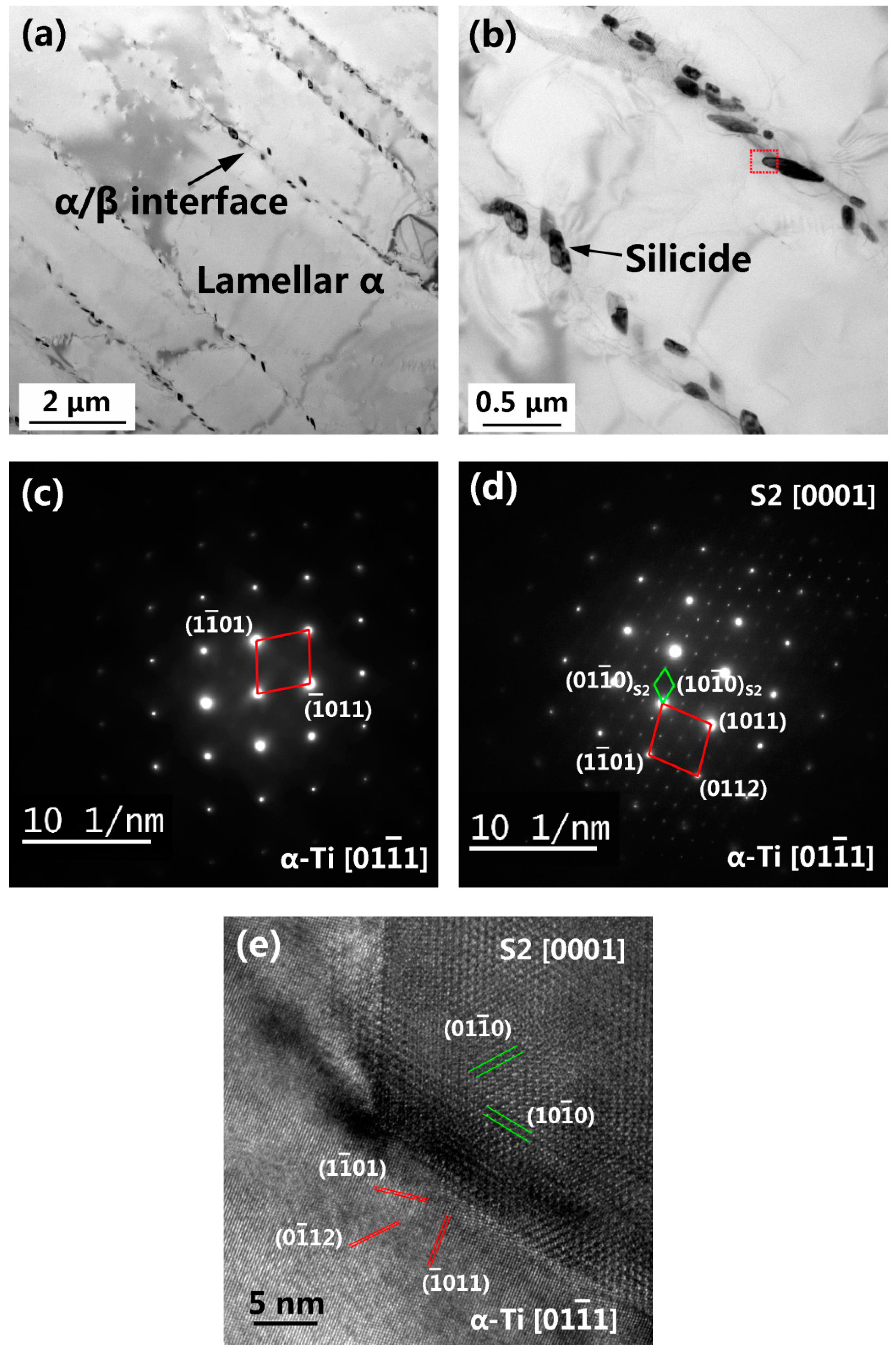
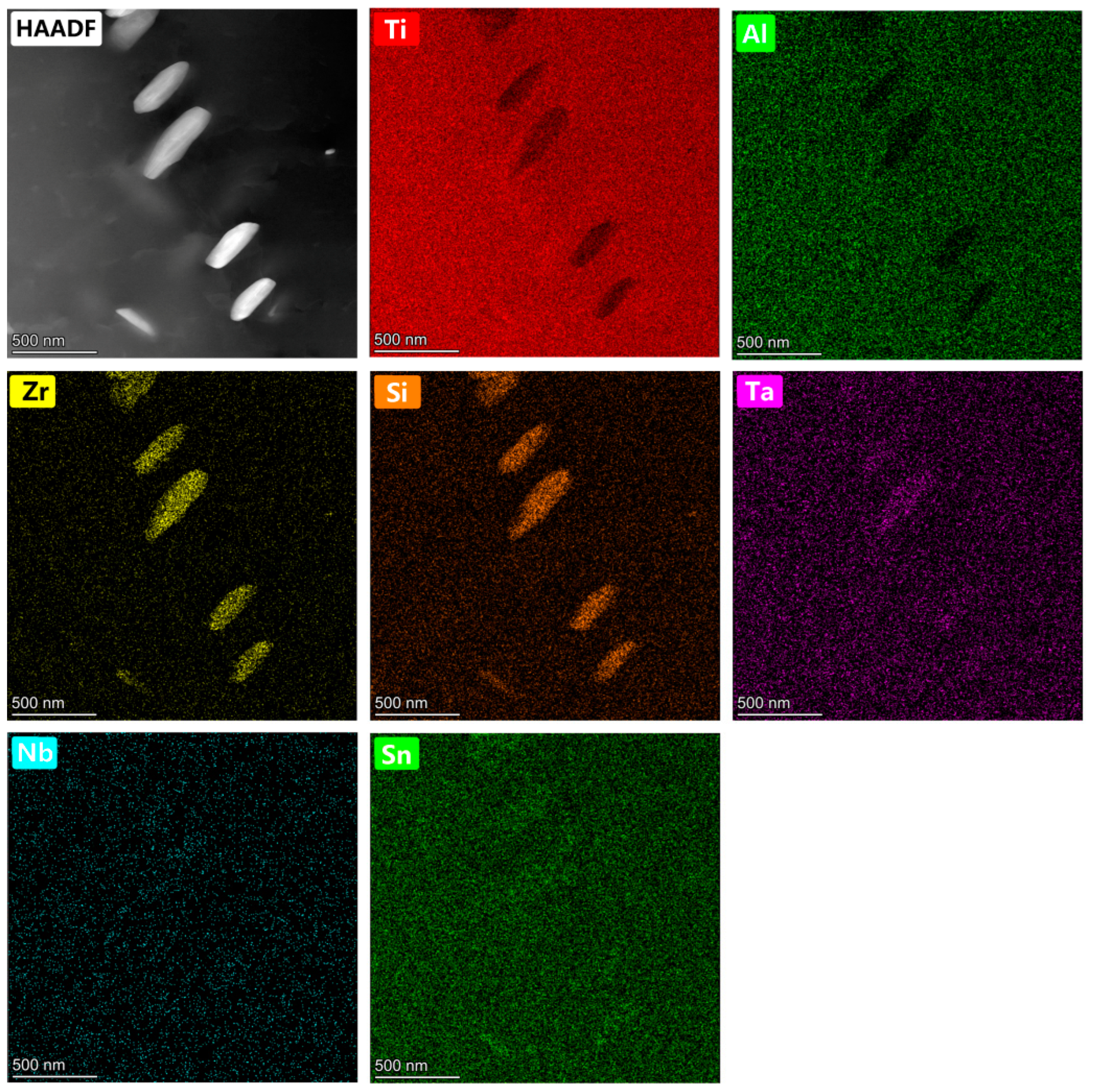
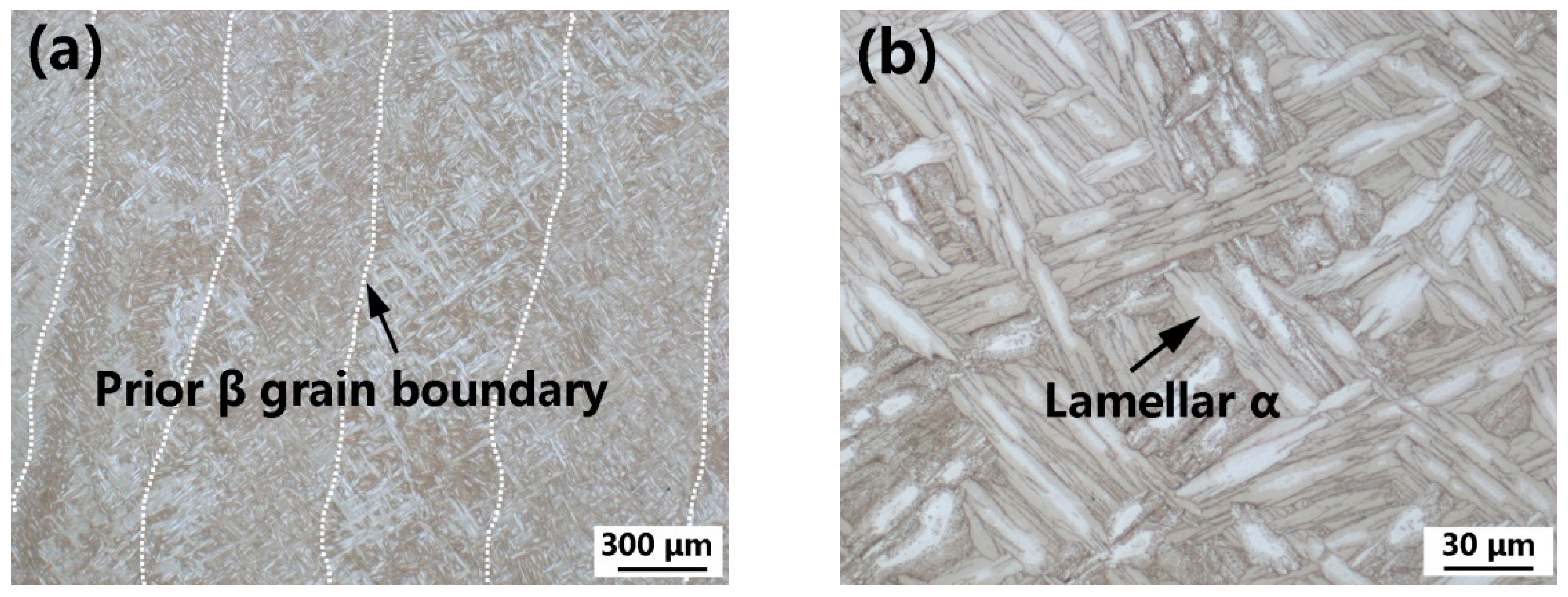
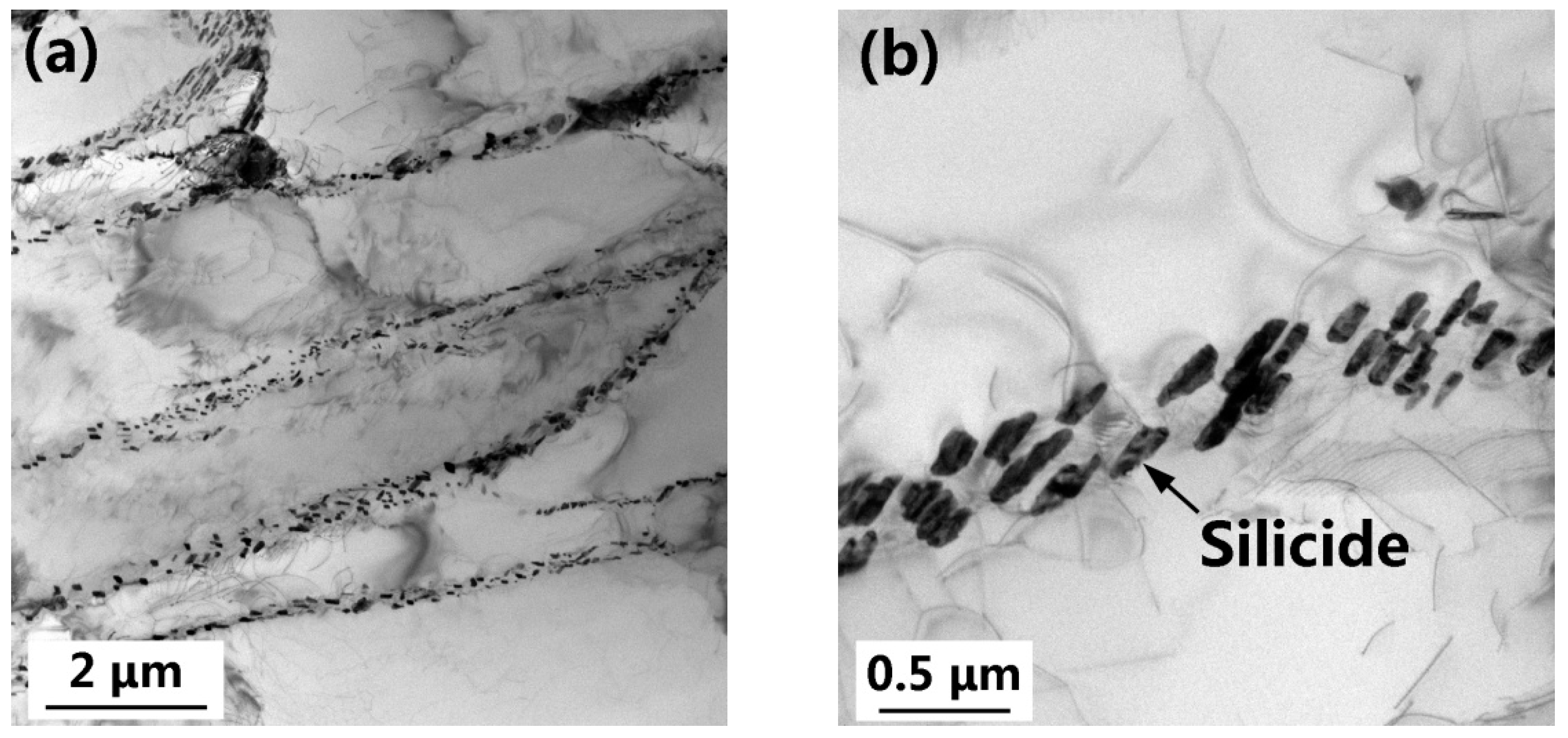

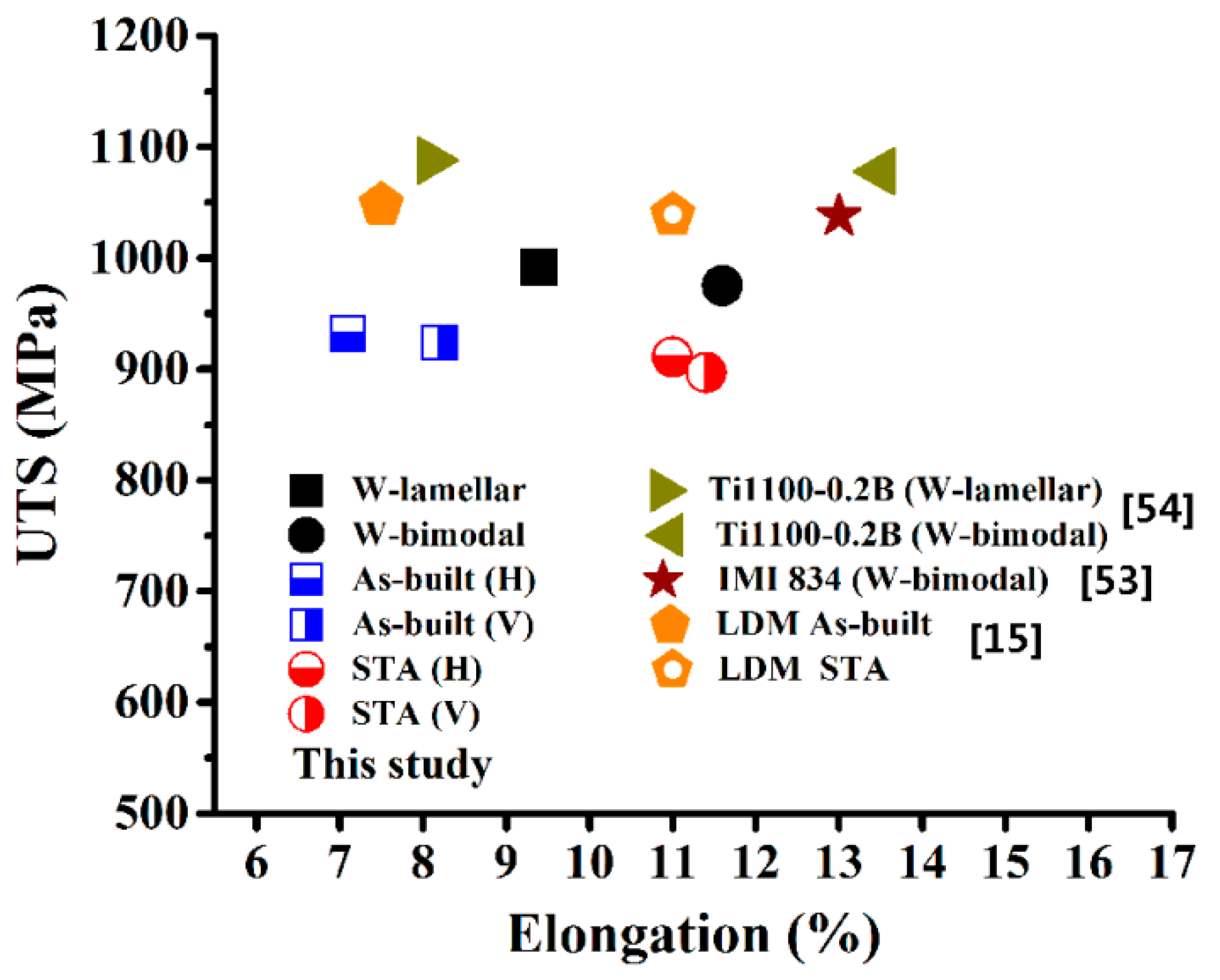



| Acceleration Voltage, kV | Beam Current, mA | Travelling Speed, mm/min | Wire Feed Rate, g/min | Hatch Distance, mm | Layer Thickness, mm | Vacuum Pressure, Pa |
|---|---|---|---|---|---|---|
| 60 | 40–50 | 600–800 | 30–40 | 3.5 | 2.0 | 4.5 × 10−2 |
| Materials | Ti | Al | Sn | Zr | Ta | Nb | Si | Fe | C | N | H | O |
|---|---|---|---|---|---|---|---|---|---|---|---|---|
| Wire | Bal. | 6.03 | 3.99 | 4.02 | 1.5 | 0.69 | 0.37 | 0.02 | 0.071 | 0.003 | 0.0044 | 0.073 |
| As-built | Bal. | 5.41 | 3.79 | 4.07 | 1.48 | 0.70 | 0.37 | 0.02 | 0.068 | 0.003 | 0.0008 | 0.073 |
| Materials | Direction | YS/MPa | UTS/MPa | EL/% | RA/% |
|---|---|---|---|---|---|
| As-built | H | 863 | 932 | 7.1 | 10.3 |
| V | 850 | 924 | 8.2 | 16.8 | |
| STA | H | 832 | 911 | 11.0 | 20.0 |
| V | 823 | 897 | 11.4 | 22.1 | |
| W-lamellar | T | 870 | 992 | 9.4 | 17.2 |
| W-bimodal | T | 862 | 975 | 11.6 | 19.7 |
| Materials | Direction | YS/MPa | UTS/MPa | EL/% | RA/% |
|---|---|---|---|---|---|
| As-built | H | 452 | 569 | 11.4 | 25.9 |
| V | 441 | 558 | 12.7 | 32.2 | |
| STA | H | 433 | 554 | 15.1 | 30.9 |
| V | 422 | 543 | 16.0 | 36.1 | |
| W-lamellar | T | 516 | 617 | 11.6 | 26.9 |
| W-bimodal | T | 502 | 602 | 13.5 | 39.6 |
| Condition | Direction | Initial Strain (%) | Total Strain (%) | Creep Strain (%) | Steady State Creep Rate (s−1) |
|---|---|---|---|---|---|
| As-built | H | 0.159 | 0.298 | 0.139 | 1.63 × 10−7 |
| V | 0.169 | 0.252 | 0.086 | 1.32 × 10−7 | |
| STA | H | 0.242 | 0.391 | 0.149 | 2.05 × 10−7 |
| V | 0.138 | 0.235 | 0.097 | 1.68 × 10−7 | |
| W-bimodal | T | 0.131 | 0.356 | 0.225 | 2.41 × 10−7 |
| W-lamellar | T | 0.166 | 0.240 | 0.074 | 1.09 × 10−7 |
Publisher’s Note: MDPI stays neutral with regard to jurisdictional claims in published maps and institutional affiliations. |
© 2022 by the authors. Licensee MDPI, Basel, Switzerland. This article is an open access article distributed under the terms and conditions of the Creative Commons Attribution (CC BY) license (https://creativecommons.org/licenses/by/4.0/).
Share and Cite
Zhang, G.; Liu, W.; Zhang, P.; Xiong, H.; Gao, J.; Yu, H.; Yuan, H. Chemical Composition, Microstructure, Tensile and Creep Behavior of Ti60 Alloy Fabricated via Electron Beam Directed Energy Deposition. Materials 2022, 15, 3109. https://doi.org/10.3390/ma15093109
Zhang G, Liu W, Zhang P, Xiong H, Gao J, Yu H, Yuan H. Chemical Composition, Microstructure, Tensile and Creep Behavior of Ti60 Alloy Fabricated via Electron Beam Directed Energy Deposition. Materials. 2022; 15(9):3109. https://doi.org/10.3390/ma15093109
Chicago/Turabian StyleZhang, Guodong, Wei Liu, Peng Zhang, Huaping Xiong, Jianshi Gao, Huai Yu, and Hong Yuan. 2022. "Chemical Composition, Microstructure, Tensile and Creep Behavior of Ti60 Alloy Fabricated via Electron Beam Directed Energy Deposition" Materials 15, no. 9: 3109. https://doi.org/10.3390/ma15093109





